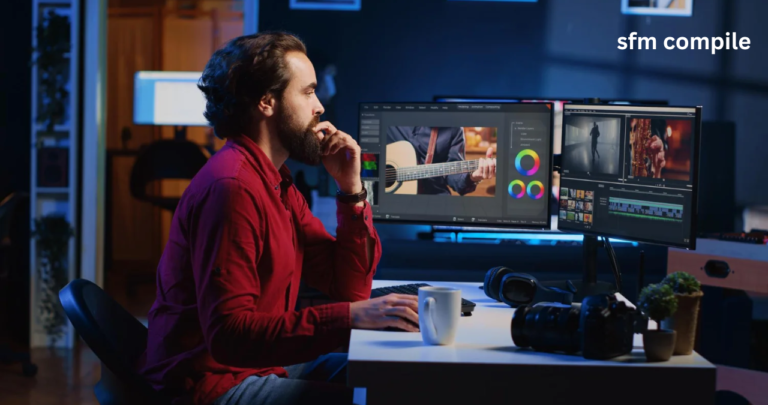Introduction
Source Filmmaker (SFM) is a powerful tool used by animators and filmmakers to create high-quality animations using Valve’s Source engine. It provides a robust suite of features, allowing users to manipulate characters, lights, cameras, and environments to produce stunning visuals. However, the final stage of the animation process—compiling—can be one of the most frustrating and challenging aspects for creators.
The compilation process in SFM refers to rendering and exporting an animation into a usable video format. Many users face issues such as long render times, poor output quality, missing textures, and crashes. Understanding the nuances of SFM compile can help animators optimize their workflow, reduce errors, and improve the quality of their final product.
This guide explores the fundamentals of SFM compilation, offering step-by-step instructions, troubleshooting solutions, and advanced techniques to enhance the final output. Whether you’re a beginner or an experienced user, this article will equip you with the knowledge needed to streamline your compilation process.
Understanding SFM Compilation

Compilation in SFM involves the process of rendering frames and exporting them into a video format or an image sequence. This step transforms the raw animation data into a playable format that can be shared or further edited in post-production software.
Rendering vs. Exporting
Rendering in SFM involves processing each frame, applying lighting, shadows, and effects before outputting the final animation. Exporting, on the other hand, refers to saving this processed animation into a usable file format, such as AVI or PNG sequences. The quality of the final product heavily depends on the settings used during these processes.
Image Sequence vs. Video Export
SFM allows users to export their projects in two main ways:
Image Sequence Export: This option saves each frame as an individual image (e.g., PNG or TGA files), which provides the best quality and avoids compression artifacts. However, it requires additional post-processing in video editing software.
Direct Video Export: This method saves the entire animation as an AVI file. While faster and more convenient, it may result in lower quality due to compression, particularly if using default settings.
Understanding these options is essential to achieving the best possible outcome for your project.
Preparing for an Efficient Compile
Optimize Scene Elements
Before compiling, it’s crucial to optimize your scene to prevent lag and reduce render times. This includes managing the number of high-poly models, limiting excessive lighting effects, and optimizing physics simulations. Keeping the project lightweight ensures a smoother rendering process.
Check Resolution and Frame Rate
Setting the correct resolution and frame rate is vital for achieving high-quality output. Most animations should be rendered in at least 1080p at 30 or 60 frames per second (FPS). Higher resolutions and frame rates increase rendering times but significantly enhance visual clarity.
Ensure Asset Integrity
Missing textures, broken models, or corrupt files can cause rendering issues or crashes. Before compiling, ensure all assets are properly loaded, textures are applied correctly, and models are functioning as expected. Running a quick test render can help identify potential issues.
Step-by-Step Guide to Compiling in SFM
Choosing the Right Output Format
Selecting the right output format is essential for maintaining quality. For best results, export an image sequence and later compile it into a video using software like Adobe Premiere Pro or DaVinci Resolve.
Rendering the Final Animation
Once settings are configured, render the animation by navigating to File > Export > Movie or Export > Image Sequence. If exporting a video file, select the correct codec and compression settings to prevent quality loss.
Troubleshooting Common Compilation Issues
Long Render Times
If your compilation is taking too long, reduce unnecessary elements in the scene, lower lighting complexity, and disable redundant particle effects. Using a powerful GPU can significantly speed up rendering.
Missing Textures and Models
To fix missing textures, ensure all assets are properly linked and reload the project. If using third-party models, verify that required texture files are included in the correct directory.
Crashes and Memory Errors
SFM may crash due to excessive RAM usage. Close background applications, increase virtual memory, or render in smaller segments to prevent memory overload.
Advanced Compilation Techniques
Third-Party Tools for Enhanced Quality
Using external software like FFmpeg can help fine-tune compression settings and improve video quality.
Multi-Pass Rendering
Rendering different elements separately (e.g., characters, backgrounds, effects) and combining them in a video editor allows greater control over the final output.
GPU Acceleration
Utilizing a GPU with CUDA or OpenCL support can significantly reduce rendering times and enhance performance.
Tips for Enhancing Final Output
Post-Processing in Video Editors
After compiling, import the video into a professional editing tool for color correction, sharpening, and visual enhancements.
Optimizing for Different Platforms
Adjust the final export settings based on the intended platform. For example, YouTube videos should be in H.264 format, 1080p at 60 FPS, while Twitch streaming requires lower bitrates.
Adding Effects and Overlays
Including additional effects, such as lens flares and cinematic color grading, can elevate the visual quality of the final animation.
Conclusion
Compiling animations in SFM is a crucial step that determines the final quality of your project. By understanding the rendering process, optimizing scene elements, and troubleshooting common issues, you can achieve professional-grade results with minimal frustration. Advanced techniques like multi-pass rendering and post-processing further enhance the final output.
SFM is a versatile tool, and mastering its compilation process will help you create stunning animations efficiently. With practice and experimentation, you’ll develop a workflow that suits your creative needs.
FAQs
1. Why does my SFM render take so long?
Long render times are usually caused by high-poly models, excessive lighting effects, or inefficient hardware. Optimizing scene elements and upgrading your GPU can help speed up the process.
2. What is the best format to export animations from SFM?
Exporting as an image sequence (PNG or TGA) provides the best quality. You can then compile it into a video using external editing software for better control over compression and effects.
3. How do I fix missing textures in my final render?
Ensure all texture files are correctly linked, reload models, and check that all assets are stored in the correct directories.
4. Can I improve the quality of my compiled video after exporting?
Yes, you can enhance quality by using video editing software for color correction, sharpening, and noise reduction.
5. Why does my compiled video look darker than in SFM?
SFM’s rendering settings may differ from the video encoding format. Adjust brightness and gamma levels in a video editor to match your intended look.
You May Also Read: https://bignewstap.com/daku-maharaj/
